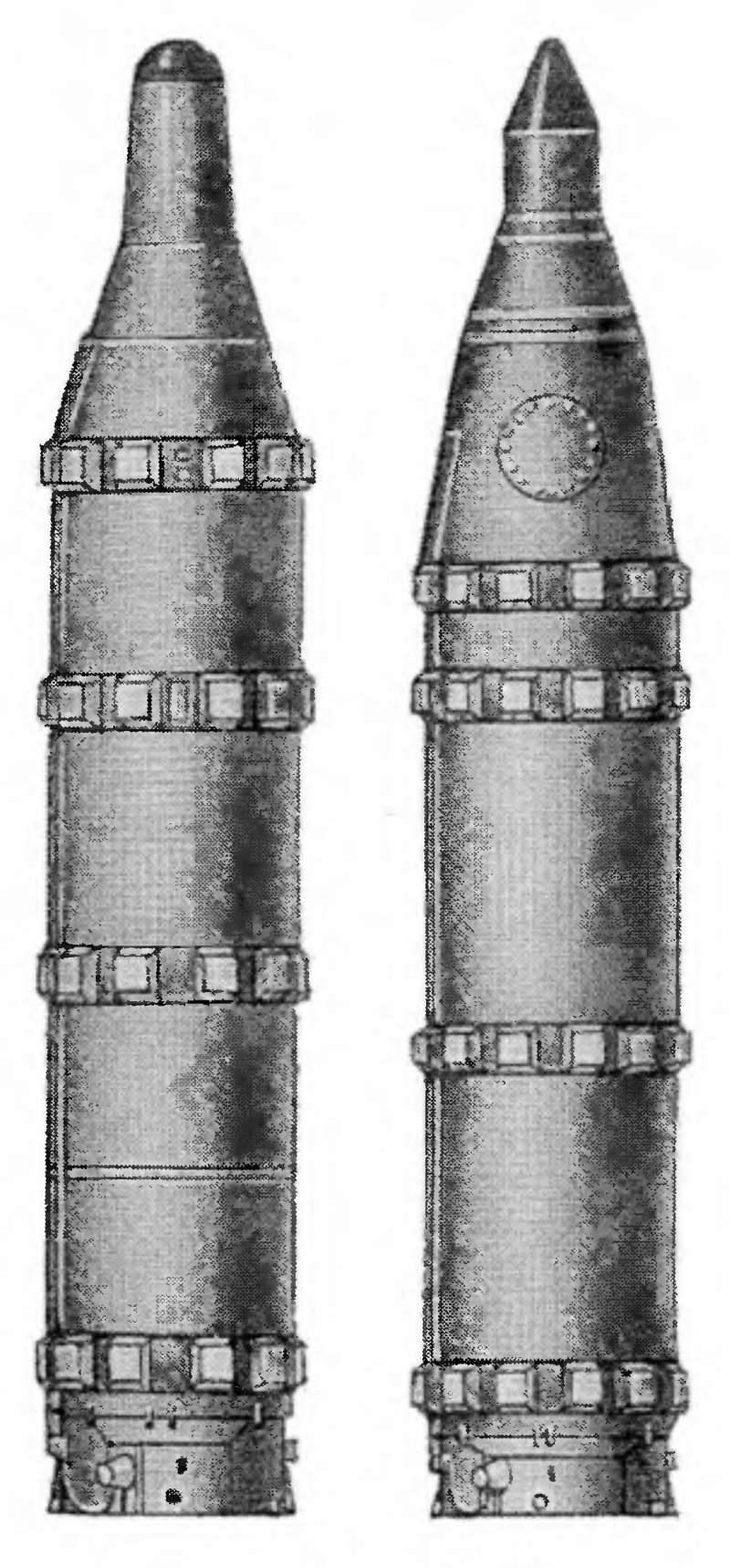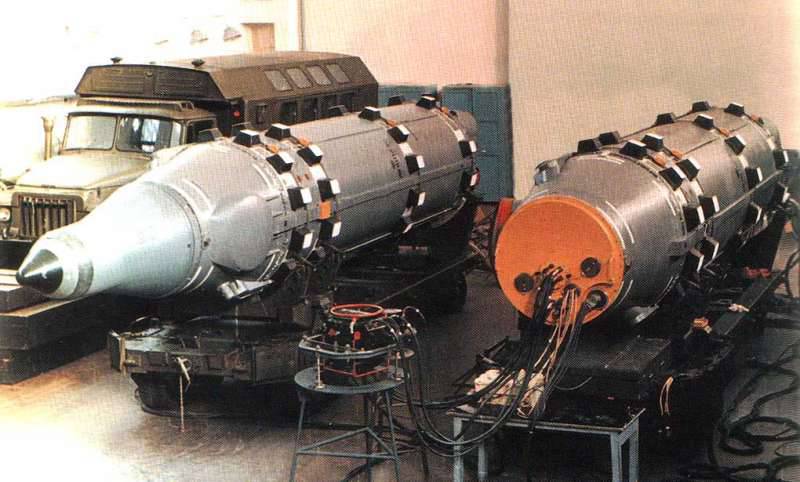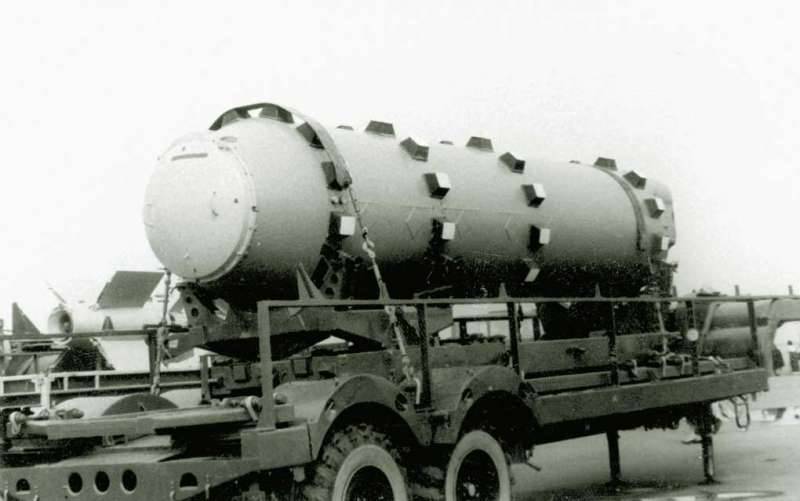Anti-ship ballistic missile R-27K
In April of the year 1962, the USSR Council of Ministers decided to begin the development of a new medium-range ballistic missile intended for use by submarines. The project of the missile complex received the symbol D-5, the rocket itself - P-27. Miassk SKB-385 (now the State Rocket Center) was appointed the developer of the project, and V.P. Makeev. Work on the project D-5 / P-27 led to the fact that in 1968, the new missile system was adopted by the submarines.
Also in 1962, there was a proposal to develop a modification of the P-27 rocket, designed to hit moving surface targets at ranges up to 900 km. An anti-ship missile called P-27K or 4K18 was supposed to be based on units of the P-27 product, but had a different purpose. In connection with the need to defeat small-sized moving targets, the anti-ship missile was to receive a set of new equipment, including a homing system.
Calculations have shown that existing detection systems can determine the location of surface targets with an accuracy of 25-30 km. At the same time, during the pre-launch preparation of the missile, the target could move 100-150 km from the previously determined point. Thus, the anti-ship ballistic missile had to be equipped with homing systems in order to independently determine the current location of the target.
Already in 1962, the general architecture of the new product was proposed, which allowed to solve the problem. It was proposed to rework the existing rocket and make it a two-stage. The task of the first stage in this case was the initial acceleration and the conclusion of the rocket on the desired ballistic trajectory, and the second stage was to find and hit the target. In addition, the avant-design of the first version offered ways to solve the main tasks of finding targets and targeting them.
It was proposed to use the second stage in the form of a streamlined unit with a radio-transparent head part and a passive side-view radar system. With the help of a folding cross-shaped antenna of the side view, it was proposed to search for signals from the ship’s electronic systems, and the final guidance was to be carried out using a passive radar GPS. It was also proposed to use rather complicated control equipment with gyroscopic devices, etc.
Early work on the P-27K project led to the formation of a range of basic tasks that were required to be solved in order to create a rocket. First of all, it was determined that the second stage of the rocket with the guidance systems is too large. It can take up to 40% of the dimensions of the entire rocket, which would have to reduce the size of the first stage and reduce the volume of its tanks. In this case, the flight range was significantly lower than required. In addition, second-stage guidance systems needed a heat-resistant fairing capable of transmitting radio signals. The required materials with such characteristics were absent at that time, and their creation required time and additional research.
Probably, the lack of ready-made developments for the manufacture of a radio transparent fairing led to the fact that in 1963, SKB-385 developed two versions of the R-27K rocket at once with different variants of guidance systems. Both pre-sketch projects used a unified first stage based on the basic P-27 units. The stage received a shortened hull with tanks for fuel and oxidizer, and also had to be equipped with a fluid engine unified with the P-27. On top of the first stage was to install the second, which has its own control systems, engine, etc.
The variant of the early project “A”, developed in 1963, implied the control of the flight by ballistic and aerodynamic methods. After resetting the first stage, the rocket, using a side-view antenna, was supposed to receive signals from the target ship and determine its locations. Then a ballistic course adjustment was made, for which short-term starts of the second-stage engine were used. With the help of one or two engine starts (the fuel supply was limited), the second stage had to go to the required trajectory.
Having passed the upper part of the ballistic trajectory, the rocket had to turn on the passive radar homing head, find the target and fly to it. For control in the atmosphere it was proposed to use aerodynamic control surfaces. This version of the two-stage ballistic-aerodynamic guidance made it possible to ensure the highest precision of impact and made it possible to use a less powerful warhead.
Option "B" suggested the use of only ballistic course correction. In the beyond-atmospheric part of the flight, the rocket had to find the target with the help of a side-view antenna, calculate the required trajectory and reach it. After returning to the atmosphere, the course correction was not envisaged. Ballistic guidance reduced accuracy and required a more powerful warhead. At the same time, such a guidance system was simple and did not require to reduce the dimensions of the first stage to more than the permissible limits, allowing it to achieve the required launch range.
After analyzing the two preliminary projects, it was decided to abandon the two-stage guidance. The implementation of the ballistic and aerodynamic course correction was associated with a lot of problems and could not be fully implemented. For this reason, the project "A" was abandoned, continuing the development of option "B". It was proposed to determine the target using a passive side-looking radar system. From the second GOS to search for targets on the descending phase of flight refused.
NII-4 was involved in the creation of a guidance system for the product 18K592. The finished control system was based on a semiconductor element base and had to solve the problem of finding a target and then calculating the flight path to it. General features of the work were determined in accordance with the preliminary draft. At the same time, some new solutions were proposed. To search for targets, it was proposed to use passive radar HSC with a cross-shaped receiving antenna. During transportation and at the initial part of the flight, the antenna should have been located in the cylindrical compartment of the second stage body. After entering the trajectory correction site, the rocket had to extend and unfold the antenna to search for target signals.
Having found the target and having calculated the optimal trajectory for its defeat, the second stage of the rocket had to adjust its course using the available engine. Fuel reserve allowed to turn on the engine twice. After correcting the course and braking, the second stage had to move to the downward part of the trajectory and follow the target.
The finished design of the P-27K rocket implied the construction of a two-stage product based on the units of the P-27 rocket. The anti-ship missile had a length of about 9 m and a diameter of 1,5 m. The launch weight was 13,25 m. The rocket of the new modification had a distinctive appearance. She received the head of a complex shape formed by several conical and cylindrical surfaces. Complicated head fairing had a greater length in comparison with the aggregates of the basic rocket P-27.
The reduced in length, the first stage with a reduced supply of fuel and oxidizer was equipped with the 4D10 liquid engine developed in OKB-2. The engine had a marching unit with a 23 ton and a steering system of two separate chambers with a total 3 ton. The engine consumed fuel in the form of asymmetric dimethyl hydrazine and nitrogen tetraoxide as an oxidizer. A curious feature of the P-27 and P-27K missile propulsion system was the placement of the engine. For the first time in domestic and foreign practice to save space, the engine was placed inside the fuel tank.
The launch of the 4K18 rocket could be carried out with the aid of a standard mine installation of the D-5 complex developed for submarines of several projects. Before launching the mine had to be flooded, and in addition, it was necessary to produce pressurized tanks to compensate for the pressure. When exiting the launcher, the rocket should have been in the so-called. gas bell, which reduced the impact of ambient water. After climbing to the surface, the rocket continued its flight to the target using the available guidance systems.
The reduction of the first stage and the volume of the fuel tanks led to a significant decrease in the flight range in comparison with the base rocket. The P-27 for hitting ground targets could fly to a range of up to 2500 km, while the anti-ship P-27K was able to attack objects only from 900 km.
It was proposed to defeat the target using a monoblock special warhead with a power of 650 kt. Such a nuclear warhead made it possible to compensate for the insufficiently high targeting accuracy and to ensure the effective defeat of enemy surface ships.

Comparison of missiles P-27K (left) and P-27 (right). Figure Shirokorad AB "Weapon domestic fleet. 1945-2000 "
For the initial target designation, it was proposed to use existing and prospective systems for detecting surface objects. During the development of the P-27K project, the Success system was based on reconnaissance aircraft. In the future, it was planned to commission the Legend system with radar reconnaissance spacecraft. The appearance of the latter allowed the use of 4K18 missiles with maximum efficiency.
The main task of SKB-385 was the development of the basic P-27 project. Because of this, the project of anti-ship weapons was created with a significant lag behind it. As a result of this lag, the D-5 rocket complex with the P-27 rocket was put into service in the 1968 year, and tests of the 4K18 missiles began only in 1970-m. One of the reasons for this lag was the difficulty in developing certain elements of the anti-ship missile.
In December 1970, the first test launch of the P-27K rocket took place at the Kapustin Yar test site. In these tests, a stationary ground stand was used. Over the next few months, 20 launches were performed. 16 launches were counted, while the rest failed. Soon, several throwing launches were performed using a sinking stand. In the course of such inspections, the product entry from the submarine launcher submerged was tested.
From the mid-sixties, the question of choosing a submarine carrier of new anti-ship ballistic missiles was resolved. The D-5 complex with the P-27K missile was proposed for use with several types of submarines. However, only the 667A, 687 and 705B projects advanced beyond the preliminary work. Such submarines had to carry from 4 to 16 new type missiles. In the future, when developing all projects, certain problems arose. For example, the 667A submarines of the project's nuclear submarines now only had to participate in strategic nuclear forces, and their use as carriers of 4K18 was considered inexpedient and unacceptable from the point of view of impact potential. The 687 and 705B projects, in turn, have encountered many technical problems. As a result, three projects have not been implemented.
By the beginning of the seventies, the question of the carrier of new missiles was not resolved, but trials with launches from the submarine were near. Because of this, it was decided to bring to trial one of the available submarines. The K-102 diesel-electric submarine of the 629 project was chosen as an experimental vessel for testing new-type missiles. It was proposed to retool the new project 605, offering the installation of four launch shafts and a number of other equipment. In particular, the navigation complex and target designation system were updated.
9 December 1972, the K-102 submarine, launched the P-27K rocket for the first time. In about a year of testing, 11 missiles were used, which were used to attack various targets. Of particular interest is the latest launch, which took place on November 3 1973 of the year. This time two 4K18 missiles were launched at a target in the form of a barge with a radar station. One of the fired missiles successfully hit the target and hit it with a direct hit. The second went to the target area with a tolerable deviation from it. It is noteworthy that by the time of the launch of the missiles, the uncertainty in the target position reached 75 km. Despite this, the passive homing system discovered the target and destroyed it. In general, the trials were successful. 10 launches from 11 have been recognized as successful.
2 September 1975 of the year, after the completion of all design and test work, a resolution was issued to close the project P-27K. Such weapons were of some interest to the fleet, but there were a number of characteristic flaws that prevented its operation. Thus, the nuclear warhead made it difficult to deploy submarines with a new type of missile in the light of the new SALT-2 agreement. Passive radar guidance system provided insufficient accuracy of guidance, and counteraction to it was quite simple. To disrupt the attack on the enemy ships, it was enough just to turn off the radar for a while. Finally, by the mid-seventies, significant progress had been made in the field of cruise anti-ship missiles.
A number of reasons made the new P-27K project useless and unpromising. Because of this, all work on the new rocket was stopped and it was not accepted for service. As a result, the navy did not receive a new unusual weapon and continued to use the existing systems of a more familiar look. However, the K-102 with the D-5 complex remained in trial operation until the early eighties.
The first domestic project of an anti-ship ballistic missile ended with a successful solution of all the tasks, but was not brought to service in the troops. The reason for this was some problems of the project, including fundamentally ineradicable. In the future, Soviet specialists made another attempt to create such weapons. A new anti-ship ballistic missile was supposed to be a product of the P-33 type, based on the design of the P-29 rocket.
Based on:
http://makeyev.ru/
http://otvaga2004.ru/
http://alternathistory.com/
http://rbase.new-factoria.ru/
http://deepstorm.ru/
Shirokorad A.B. Weapons of the domestic fleet. 1945-2000. - Minsk: “Harvest”, 2001





Information